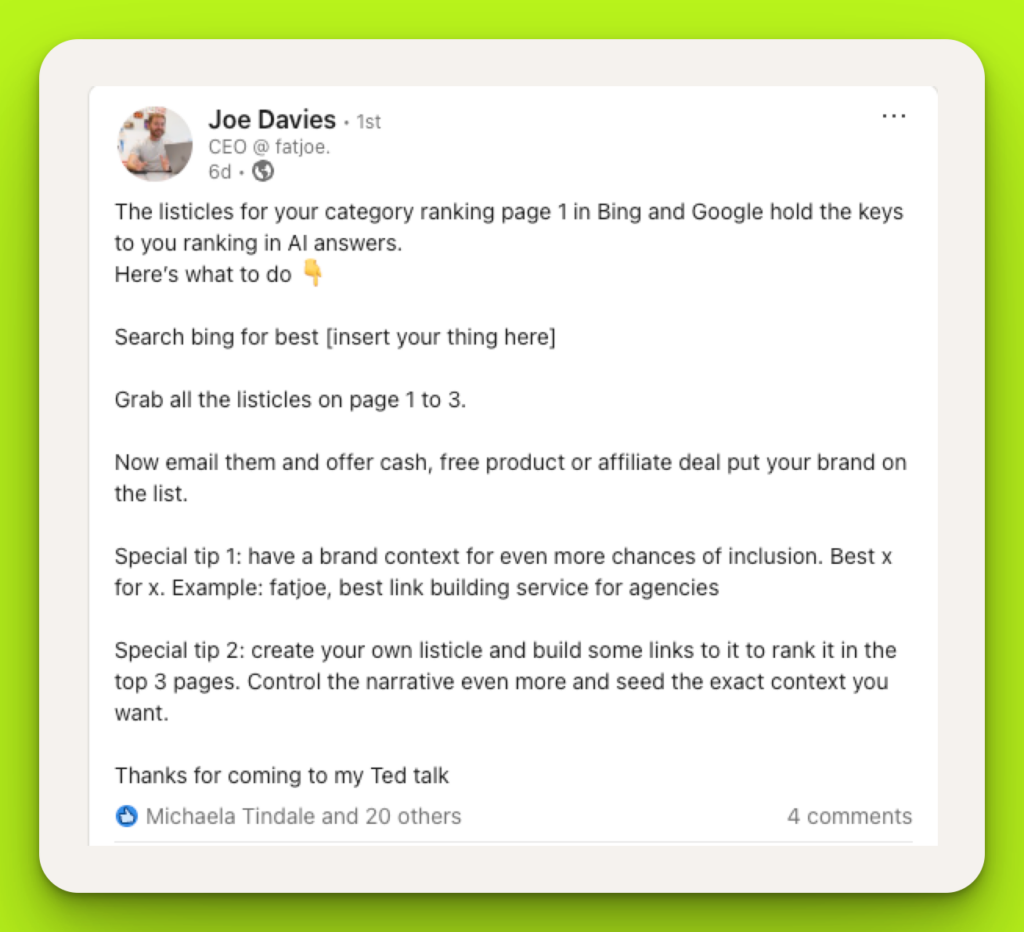Search is changing.
AI chatbots like ChatGPT, Claude and Perplexity are answering questions directly, and Google’s new AI Overviews (formerly SGE) put AI-powered summaries front-and-centre at the top of the SERP.
And midway through the SERP.
And who knows where else as they continue to experiment.
Whether you call it AI SEO, regular SEO, AEO (Answer Engine Optimization), GEO (Generative Engine Optimization)… or anything you choose, it’s here to stay.
We’re going to go ahead with “AI SEO” – the art and science of being recommended and cited in AI responses, to keep things simple.
It’s eating up SERP clicks and driving referral traffic.
We’re going to assume you’re already sold on the value of appearing in AI – you’re a forward-thinking SEO after all.
We’ll break down the three key strategies we’re using to appear in AI responses, plus some advanced additional tactics to boost your brand’s AI awareness.
AI SEO: How To Appear In AI Responses And Rank In AI Overviews
Build Brand Authority with Digital PR
The first step in AI SEO is to invest in high-tier digital PR to get your brand mentioned by authoritative publishers. Winning coverage in major media and niche trade sites does two things: it creates strong backlinks and spreads your brand’s exact messaging.
Just like how regular SEO involves identifying key ranking factors and tailoring your site’s profile to those factors, AI SEO involves much the same – in this case leaning on how AI models factor in the trustworthiness and reputation of potential sources or recommendations.
AI models heavily rely on mentions in trusted contexts to help ground their responses and recommendations, so securing this kind of coverage should be a priority.
We’ve used this AI SEO tactic ourselves, using fatjoe’s own Digital PR Campaigns to target premium outlets like Forbes, MSN, NYPost and others to secure these mentions.
Just look at how it worked here – we’ve been recommended on the back of ChatGPT picking up positive coverage we secured via a digital PR campaign.
Landing your story or expert quotes on such sites means AI crawlers (and Google’s knowledge overviews) are far more likely to “see” your brand.
In short, treating AI SEO visibility like a PR effort ensures your brand name and core phrases are replicated widely on the web.
Create Topical, High-Quality Content
Next, produce expert content on your brand’s core topics.
Again this AI SEO tactic builds on the fundamentals of regular SEO – it’s just about drilling down to the specific SEO factors that affect AI SEO too.
Authoritative, in-depth blog posts aligned with your expertise not only boost regular SEO, they also fuel AI training data.
AI doesn’t know everything – it regularly has to recrawl content to build responses to unique and ever-changing queries.
You can leverage this by continuing to produce great quality content that then feeds AI responses, positioning you as an expert and making it clear to searchers that you are being trusted to provide accurate answers.
Keep content fresh and updated. Many AI tools now use “live” web lookups (via Bing API, etc.), so being indexed by Google/Bing is a prerequisite for citation.
Luckily, all the classic SEO techniques still apply. Fast page speed, mobile-friendly design, and clean site structure all help your pages rank quickly after publication, ensuring they can show up in real-time AI answers.
Listicles Are The New Hotness: Earn “Best X” & “Top Tools” Mentions To Win AI SEO
This is possibly the most powerful AI SEO tool to earn direct recommendations when ChatGPT and similar tools generate recommendations for services/products/anything else you offer – listicles.
Yepp, the 2014 classic – a good old ‘listicle’.
Target the transactional queries too: get your brand in those coveted “best-of” and “top tools” lists.
When users ask AI for recommendations (e.g. “best email outreach tools”), the answers often draw from roundup articles or listicles. By securing backlinks and mentions on these list pages, you ensure your brand is in the shortlist AI cites.
This is another classic SEO technique – funny how that keeps happening – but it’s absolutely worth the hard work you need to put in to secure these specific mentions.
This isn’t just a scattergun approach; it’s laser-targeted outreach for key terms, and it helps regular SEO too.
Ahrefs calls it “Second Hand Search Traffic” – it’s a great way to appear in SERP real estate even for the most competitive terms – and now it helps your “AI SEO” too.

“But how do I get listed in these listicles?”
Easy – be the best choice for your niche within your industry.
Not quite there yet? Follow Joe’s listicle outreach principles here – and don’t forget to build your own listicles too!
Or, even easier, use fatjoe’s Brand Mentions service to secure positive coverage in reviews and listicles.
Appear In UGC Comments and Posts
UGC platforms are instrumental for AI SEO.
Semrush found that Reddit and Quora were the two most cited domains in AI Overviews, and similar levels of visibility carry over to other AI like ChatGPT and Claude.
You can manually work to build comments and posts mentioning your brand positively, but its hard work and liable to be removed by moderators if they consider it promotional.
fatjoe’s Community Mentions service secures positive Reddit comments, Quora comments, and industry-specific forum answers to build your positive brand profile in AI.
Additional AI SEO Tactics To Appear In AI Responses
The key summary here is: optimize your content to be “readable” to AI.
That isn’t quite the same as optimizing for human readability, but luckily it’s close.
- Use Q&A-style headings. Structure your content like a Q&A. Use clear question headings (“What is…?”, “How to…?”, “Why does X happen?”) and put the answer immediately below them.
This “Q&A format” aligns perfectly with how people query AI and how LLMs select answers.
Similarly on structuring your content Mike King recommends implementing clear semantic units and Subject Predicate Object patterns to make content super-readable for AI.
- Implement Schema Markup. This one is still up for some debate – after a flurry of recommendations SEOs are pushing back against schema as something that directly affects AI readability.The thing is, it’s still great for machine understanding of your content and would never harm your SEO/AI response optimization, so it’s still worth it to invest in optimizied schema markup.
- Ensure consistency and entity alignment. Be consistent in how you mention your brand and core terms. LLMs literally count co-occurrences of words. If a phrase appears often with your brand, the model “learns” to link them.
Use the same brand phrasing everywhere: your homepage, bylines, author bios, PR stories, and guest posts should all repeat your unique selling line or tagline.
We’ve covered before the value of semantic SEO but SEOs are going deeper than ever using vector embedding and more to understand the semantic context of their own content, and the semantic gaps between what they feel they cover, and what AI feels they are relevant to.
Wil Reynolds is doing some great work on this with his case for “semantic distance” reporting.
AI SEO: It’s Just SEO, Jeff.
So, what do you need to do to appear in AI responses and to rank in AI overviews?
SEO.
ALL of the “AI SEO” tactics above are regular SEO tactics we’ve been preaching – and using – for years.
You can bring a more focused approach to your outreach, brand building and content creation to optimize SEO for AI specifically, but ultimately your best approach is to continue with quality SEO tactics.
Become a Pro at SEO
Join 65,000 others and learn the secrets to SEO success with our weekly blog posts.

